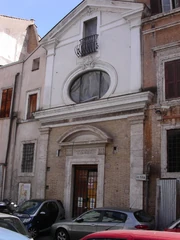San Simeone Profeta is a ruined 17th century former parochial and confraternity church in the Piazza Lancellotti, hidden away in the rione Ponte just north of the Via dei Coronari.
It is dedicated to St Simeon Senex, the old man who embraced the baby Jesus during his presentation at the Temple in Jerusalem. Beware of the spelling Simone in online sources.
History[]
The church was first mentioned as parochial in 1017, under the name San Simeone de Ponte, but was probably much older than that. In the Catalogus Cencii Camerarii of 1192 it is listed as San Simone de Posterula.
It was made titular by Pope Sixtus V (1585-90) in 1551, after a restoration. The cardinalate only lasted until 1587, when it was suppressed. The last titular was Scipione Lancelloti. However, a relative of his named Orazio Lancellotti rebuilt the church in 1610, as the family palace was nearby, and provided the altars with paintings. it remained a parish church until 1824. The upper storey of the façade was remodelled in 1741.
A major re-ordering of the parishes of the Centro Storico took place in 1824, under the bull Super Universam issued by Pope Leo XII. This suppressed the parish attached to the church, and transferred its territory to the newly erected parish church of San Salvatore in Lauro. The old church was then entrusted to the Archconfraternity of Saint Margaret of Cortona, which rededicated it as Santa Margherita da Cortona. (There is some doubt as to whether it was formally rededicated, or whether this was just a nickname.)
This confraternity seems to have had little success here. At the end of the 19th century the church had no serving priest and was closed, and was abandoned completely after the collapse of the roof in 1929. There is still a Confraternita di Santa Margherita da Cortona in Rome, but it is based at the Lateran.
Only the façade remains, and the plot occupied by the church seems to be part of a private garden. However, the façade was recently restored and is sound.
Exterior[]
The pretty little two-storey façade remains in good condition. The first storey is in pale brown brick with limestone architectural details, and the second storey is rendered in white. The corners of the former are occupied by a pair of Doric pilasters supporting an entablature, the thin frieze of which had an inscription which it is now difficult to make out. The cornice of this entablature is strongly projecting, and rather out of proportion.
The former entrance has a stone doorcase which is molded, and over the lintel of this is an inscription: S[ancto] Simeoni Prophetae H[oratius] Lancelottus ("Orazio Lancellotti (gives this to) St

There is nothing behind this façade.
Simeon the Prophet"). This inscription looks as if it had been covered up when the church was dedicated to St Margaret. On either side of it is a carved triglyph, and over it is an oversized segmental pediment.
The second storey has another pair of Doric pilasters with oversized capitals, directly over the first pair and supporting a triangular pediment. Into this is inserted a rectangular window with a bowed wrought iron balcony, which breaks the line of the pediment's cornice. In the middle of the storey is a large oeil-de-boeuf window with a raised frame topped by a scallop shell motif. There is a winged putto's head in the top angle of the pediment.
Interior[]
The narrow façade gives the impression of a very small church, but this was not so. The entrance led into a small narthex, which widened out into the nave which was basilical in plan. There were side aisles separated by arcades having four pillars each, and a pair of pilasters framed the main altar. There was no transept, sanctuary or apse.
The Nolli map of 1748 shows two side altars on each side, but descriptions of the church layout mention only two in total.
The main altar had an altarpiece of The Circumcision by Ventura Salimbeni. The right hand altar had an important painting by Carlo Saraceni showing Our Lady and Child with St Anne, and the left hand altar had an anonymous 17th century work. There was a tomb of Lorenzo Genusino dating from 1498, and one of Ludovico Vestarini of 1820.
The Saraceni is now in the Galleria Nazionale d'Arte Antica.
External links[]
"De Alvariis" gallery on Flickr